You know those unexpected food discoveries that just stick with you forever? That's how I stumbled upon the best Pork Humba of my life at this tiny carinderia in Quezon Province during an awkward road trip with my ex and his barkada.
There I was, trying to survive the longest 4 hours of my life, when this heavenly aroma pulled me into a humble eatery along Maharlika Highway. One bite of their Visayan Humba, with its melt-in-your-mouth pork belly swimming in that sweet-savory sauce, and suddenly the whole uncomfortable situation didn't matter anymore.
Hindi ako nagbibiro, this dish literally saved that day. Now after countless attempts to recreate that Pork Humba, I've finally perfected my own version that brings me right back to that random Tuesday in Quezon.
This recipe's got that same magic: tender liempo that's been slow-cooked in pineapple juice and toyo, with tausi and banana blossoms adding that distinctive Visayan twist that makes it so much more special than your usual adobo.
Jump to:
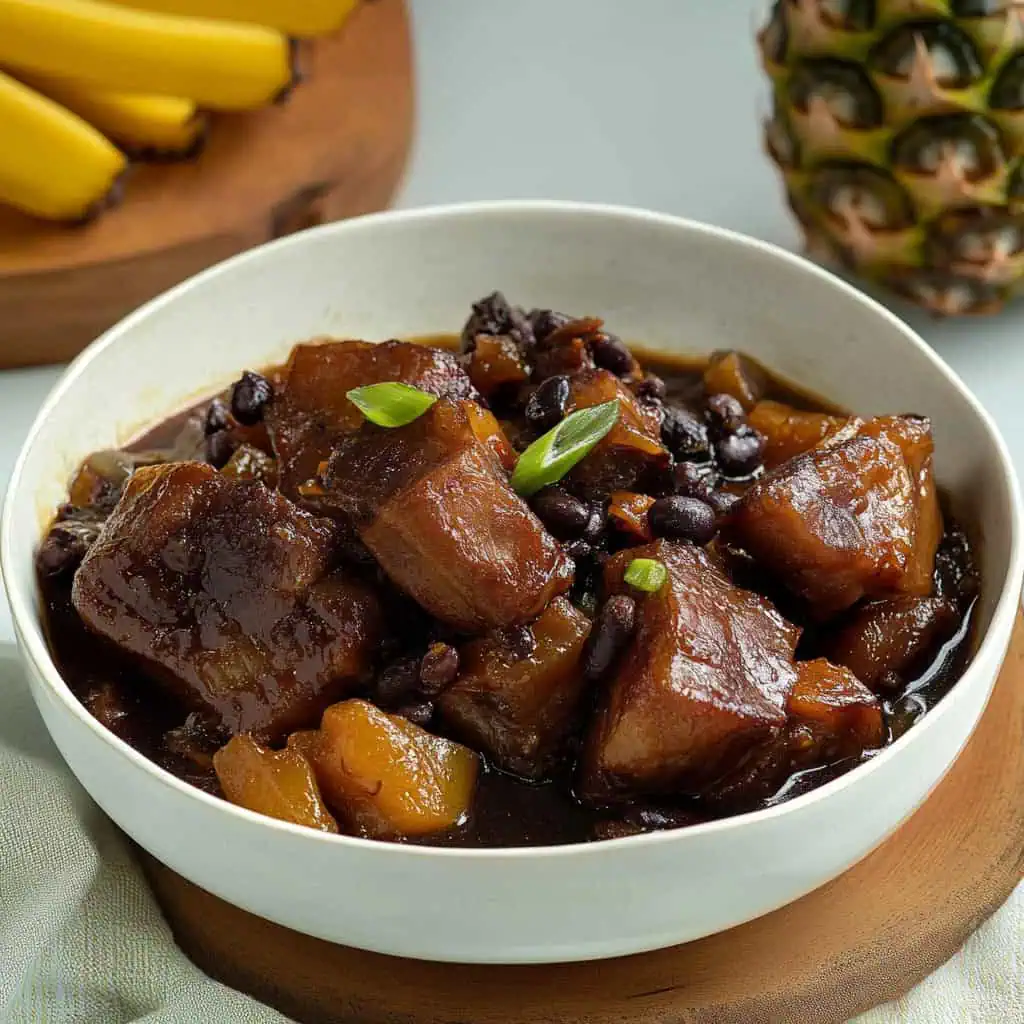
Why You'll Love This Recipe
- Fork-Tender Meat: The slow-braising process transforms tough pork belly into butter-soft meat
- Complex Flavors: Perfect balance of sweet, salty, tangy, and umami notes
- Make-Ahead Friendly: Tastes even better the next day
- Heritage Recipe: An authentic Visayan dish passed down through generations
- Crowd Pleaser: Impressive enough for special occasions but simple enough for Sunday family meals
- One-Pot Wonder: Everything cooks in a single pot for easy cleanup
Ingredients
This harmonious blend of ingredients creates the perfect balance of flavors in traditional Visayan Humba. The pork belly provides rich texture and depth, while pineapple juice tenderizes the meat and adds natural sweetness. Fermented black beans (tausi) deliver a distinctive umami foundation that sets Humba apart from adobo.
The banana blossoms absorb all the complex flavors while adding subtle earthiness and unique texture. Together, they create that sweet-savory magic that makes this dish unforgettable.
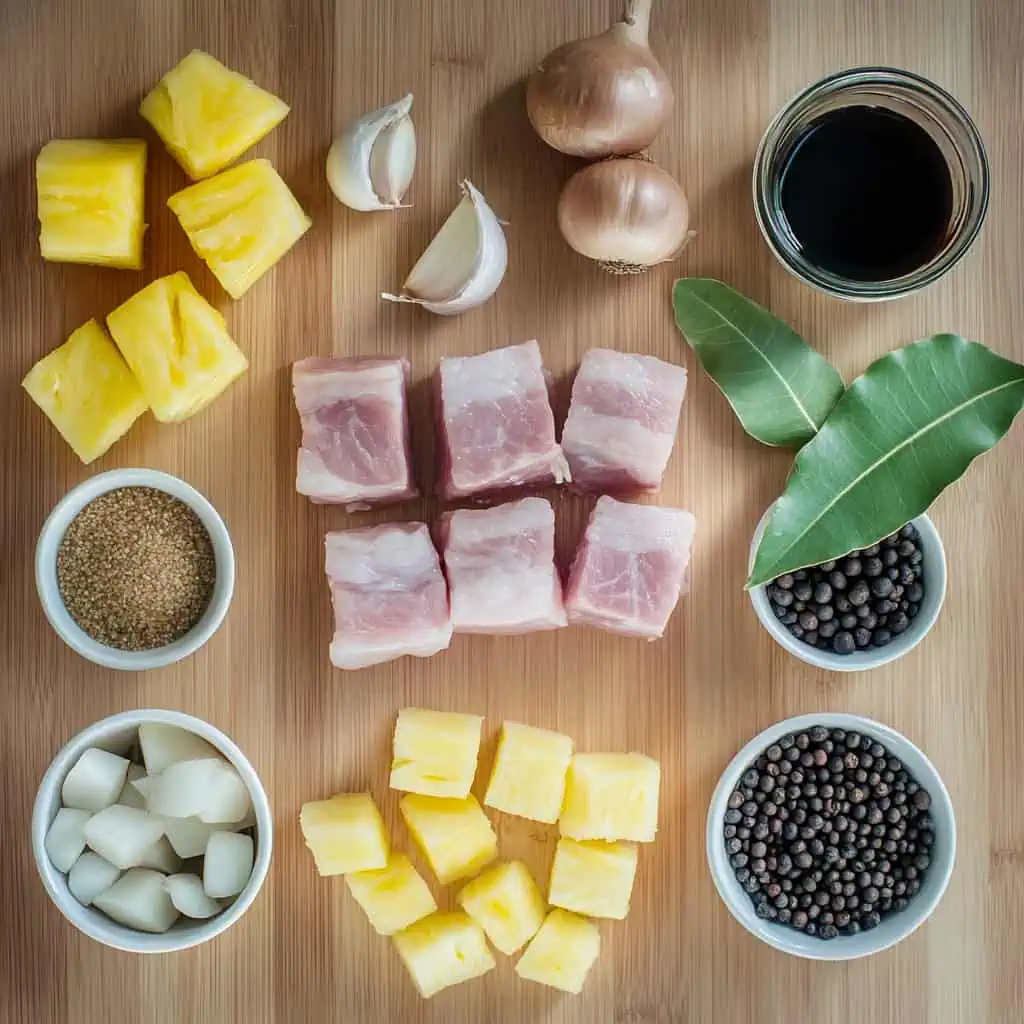
For the Meat and Marinade:
- 2 pounds pork belly (liempo), cut into 1.5-inch cubes
- ¼ cup vinegar
- ½ cup soy sauce
- 1 cup pineapple juice
For Cooking:
- 1 tablespoon cooking oil
- 1 medium onion, finely sliced
- 6 cloves garlic, minced
- 1 teaspoon whole peppercorns
- 2 bay leaves
- 1 can (6 oz) fermented black beans (tausi), rinsed and drained
- 1 cup pineapple chunks
- 1 oz dried banana blossoms
- 1 tablespoon brown sugar
- Salt to taste
Equipment Needed
- Large heavy-bottom pot or Dutch oven: Distributes heat evenly for slow braising and prevents burning.
- Mixing bowl: Used for marinating the pork belly.
- Sharp knife: Essential for cutting pork belly into uniform cubes for even cooking.
- Measuring cups and spoons: Ensures recipe accuracy for balanced flavors.
- Wooden spoon: Gentle stirring without scratching your pot, perfect for checking sauce consistency.
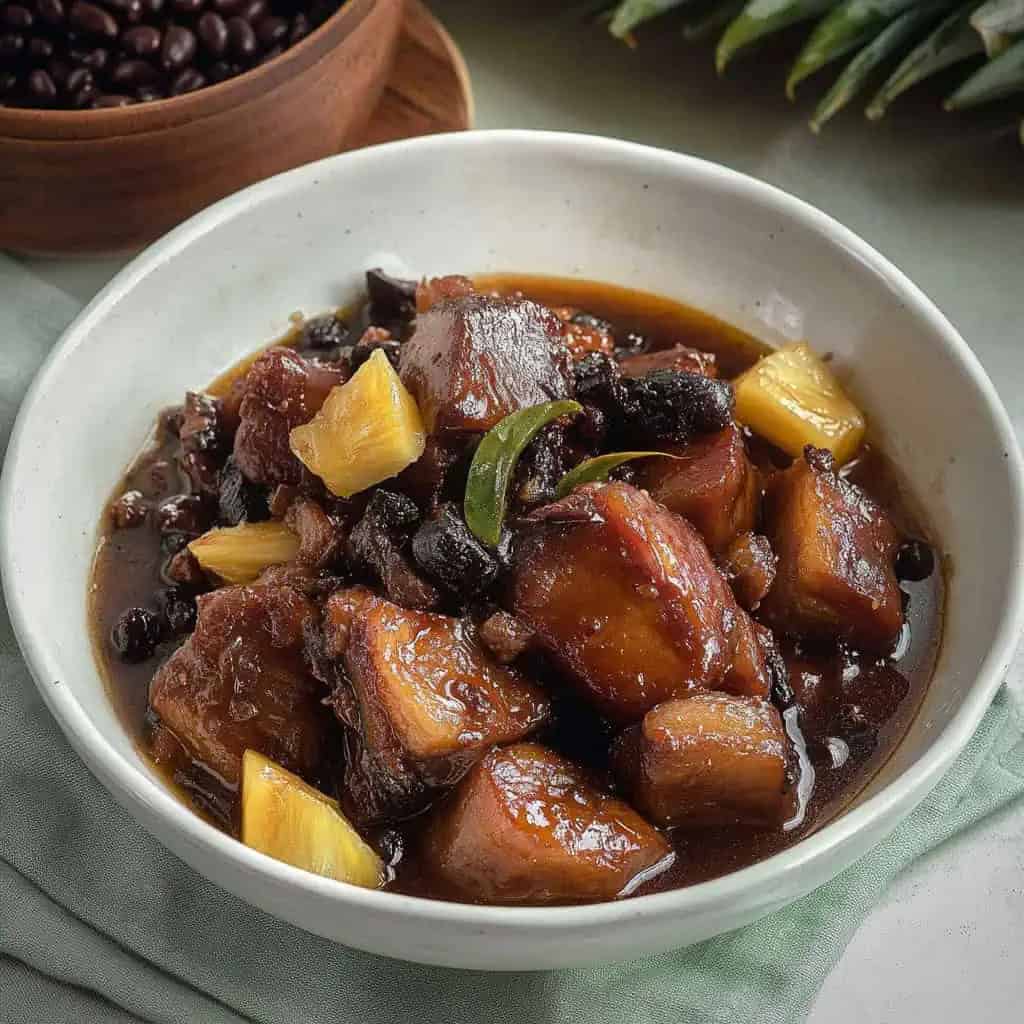
How To Make
- Prepare the pork and ingredients: Cut pork belly into uniform 1.5-inch cubes. Rinse tausi thoroughly under cold water to remove excess salt. Soak dried banana blossoms in warm water for 15 minutes, then drain and set aside.
- Marinate the pork: Combine vinegar, soy sauce, and pineapple juice in a non-reactive mixing bowl. Add pork belly, ensuring all pieces are well-coated. Refrigerate for 30 minutes only.
- Prepare aromatics: Slice onion finely and mince garlic. Heat oil in your heavy pot over medium heat until shimmering.
- Start cooking: Add sliced onions and cook until transparent (2-3 minutes). Add minced garlic and cook for another minute until fragrant. Drain marinated pork (reserve marinade) and add to pot. Brown on all sides (5-7 minutes).
- Build the braising liquid: Pour in reserved marinade and bring to a boil. Add peppercorns and bay leaves.
- Add signature ingredients: Add rinsed tausi, pineapple chunks, and soaked banana blossoms. Reduce heat to low, cover, and simmer, stirring occasionally every 20 minutes.
- Low and slow cooking: Simmer for 1.5-2 hours until meat becomes fork-tender. Add brown sugar after about an hour of cooking.
- Finish the dish: Continue cooking until sauce has reduced and thickened enough to coat the back of your wooden spoon. Look for clear oil pools forming on the surface and meat that easily falls apart when pressed.
- Rest and serve: Remove from heat and let rest for 15 minutes. Serve hot over steamed white rice.

Tips from Lola's Kitchen
- Meat selection: Choose pork belly with visible layers of fat and meat for the best texture.
- Marination caution: Never exceed 30 minutes of marination—the acid will make your meat mushy.
- Patience pays off: Don't rush the cooking process; low and slow creates that melt-in-your-mouth texture.
- Oil indicator: When you see little pools of clear oil forming on top, your Humba is ready.
- Next-day magic: Humba always tastes better the day after cooking, as flavors continue to develop overnight.
Substitutions
- Alternative pork cuts: Pork shoulder, pork hocks, or pork leg work well if belly isn't available.
- Other sweeteners: Palm sugar, muscovado sugar, or coconut sugar can replace brown sugar.
- Acid alternatives: Apple cider vinegar, calamansi juice, or rice vinegar can substitute for white vinegar.
- No banana blossoms?: Try young bamboo shoots, heart of palm, or mushrooms for similar texture.
Troubleshooting
- Tough meat: Extend cooking time on consistent low heat. Prevention: choose quality meat and practice patience.
- Too salty: Add a quartered potato to absorb excess salt (remove before serving). Prevention: rinse tausi thoroughly.
- Sauce too thin: Simmer uncovered until reduced to desired consistency.
- Sauce too thick: Add small amounts of pineapple juice or water to thin it out.
Storage & Reheating
- Refrigerator storage: Keeps 3-4 days in an airtight container. Cool completely before storing.
- Freezer option: Lasts up to 2 months in a freezer-safe container.
- Stovetop reheating: Medium heat for 7-10 minutes, stirring occasionally.
- Microwave reheating: Heat in 2-3 minute intervals, stirring between.
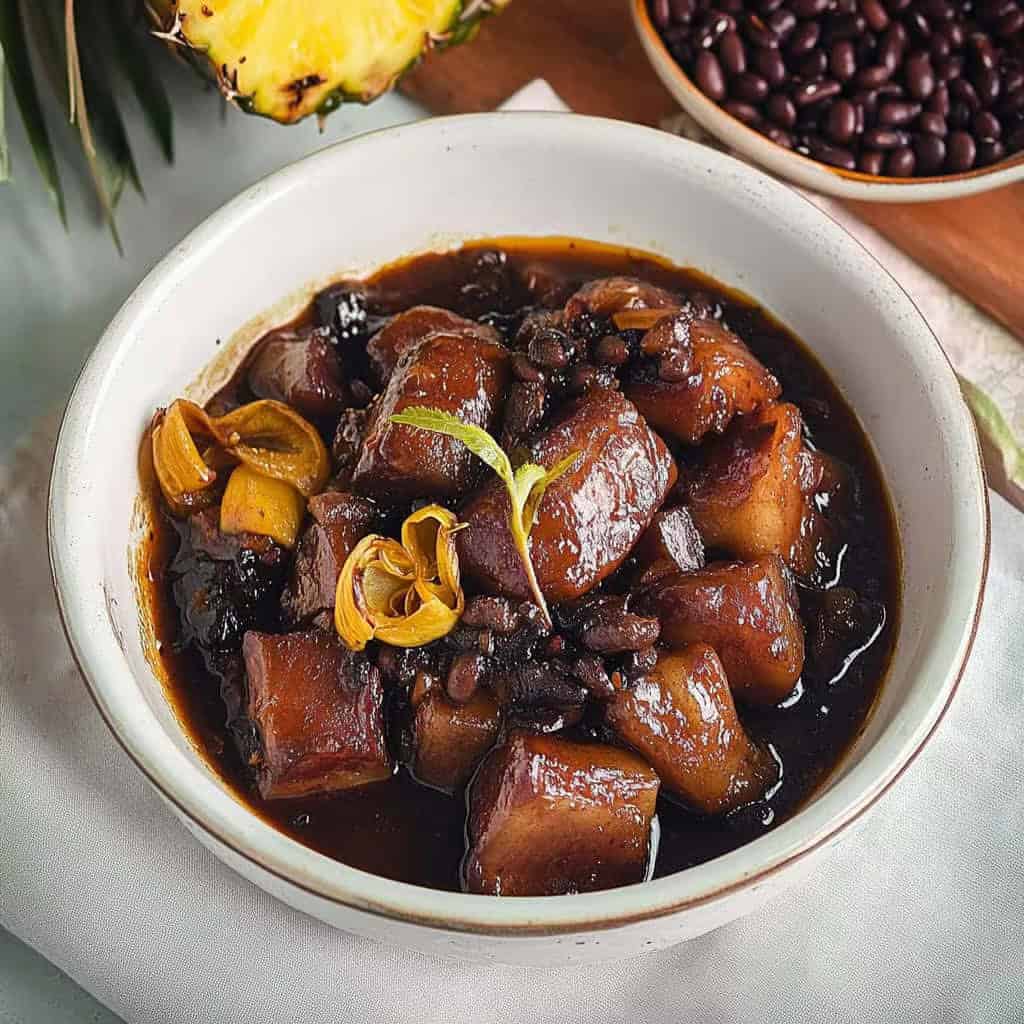
FAQ
Can I make this in a slow cooker?
Yes! Cook on low for 6-8 hours or high for 4-6 hours. Add the pineapple in the last hour to prevent it from becoming too soft.
Why is my pork not getting tender?
The key is low and slow cooking. If still tough, continue cooking on low heat until tender. Different cuts may require different cooking times.
Can I make this ahead for a party?
Absolutely! The flavors actually improve after a day or two. Store properly and reheat gently before serving.
What makes this different from regular adobo?
The addition of tausi, banana blossoms, and pineapple gives Humba its distinct flavor profile and sets it apart from traditional adobo.
Can I reduce the fat content?
Yes, you can trim excess fat from the pork belly or use leaner cuts like pork shoulder, though this may affect the final texture and richness.
How spicy is traditional Humba?
Traditional Humba isn't spicy at all. However, you can add bird's eye chilies or chili garlic sauce if you prefer a spicy version.
Related
Looking for other recipes like this? Try these:
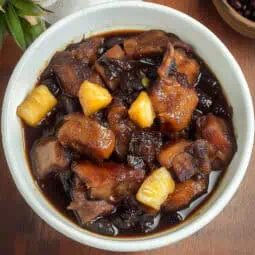
Visayan Pork Humba (with Pineapple & Banana Blossoms)
Equipment
- Large heavy-bottom pot or Dutch oven (kaldero)
- Mixing bowl for marinating (mangkok)
- Sharp knife (kutsilyo)
- Measuring cups and spoons (Panukat)
- Wooden spoon (sandok na kahoy)
Ingredients
For the Meat and Marinade:
- 2 pounds pork belly liempo, cut into 1.5-inch cubes
- ¼ cup vinegar suka
- ½ cup soy sauce toyo
- 1 cup pineapple juice katas ng pinya
For Cooking:
- 1 tablespoon cooking oil mantika
- 1 medium onion sibuyas, finely sliced
- 6 cloves garlic bawang, minced
- 1 teaspoon whole peppercorns paminta
- 2 bay leaves dahon ng laurel
- 1 can 6 oz fermented black beans (tausi), rinsed and drained
- 1 cup pineapple chunks pinya
- 1 oz dried banana blossoms puso ng saging
- 1 tablespoon brown sugar asukal na pula
- Salt to taste asin
Instructions
- Begin by preparing your pork belly (liempo). Take your sharp knife (kutsilyo) and cut the meat into uniform cubes about 1.5 inches in size. Make sure your cuts are even to ensure consistent cooking. Take your fermented black beans (tausi) and rinse them thoroughly under cold running water to remove excess salt. Place your dried banana blossoms (puso ng saging) in a bowl of warm water at 35°C/95°F and let them soak for 15 minutes, then drain and set aside.
- Create your marinade by combining vinegar (suka), soy sauce (toyo), and pineapple juice (katas ng pinya) in a non-reactive mixing bowl (mangkok). Add your cubed pork belly to the marinade, making sure all pieces are well-coated. Place the bowl in the refrigerator set at 4°C/39°F and marinate for exactly 30 minutes - no longer, as the acid can start breaking down the meat too much.
- While the meat marinates, prepare your aromatics. Slice your onion (sibuyas) finely and mince your garlic (bawang). Set your stove to medium heat (175°C/350°F) and place your heavy-bottom pot or Dutch oven (kaldero) on the burner. Add your cooking oil (mantika) and let it heat up until it shimmers.
- Add your sliced onions to the hot oil and cook them until they become transparent and soft, about 2-3 minutes. Add your minced garlic and cook for another minute until you can smell its aroma. Remove your marinated pork from the refrigerator and drain it, but save the marinade - you'll need it later.
- Add your drained pork to the pot and cook until it develops a light brown color on all sides, about 5-7 minutes. Pour in your reserved marinade and bring the mixture to a boil. Once boiling, add your whole peppercorns (paminta) and bay leaves (dahon ng laurel).
- Now add your rinsed tausi, pineapple chunks (pinya), and the soaked banana blossoms to the pot. Reduce your heat to low (150°C/300°F) and cover the pot. Let everything simmer together, giving it a gentle stir every 20 minutes or so. The meat needs to cook slowly for about 1.5 to 2 hours until it becomes tender enough to cut with just your fork.
- After about an hour of cooking, add your brown sugar (asukal na pula). Continue cooking until the sauce has reduced and thickened - it should coat the back of your wooden spoon (sandok na kahoy). You'll know your humba is ready when you see clear oil pools forming on the surface, the meat easily falls apart when pressed, and the internal temperature of the meat reaches 90°C/195°F.
- Once done, remove the pot from heat and let your humba rest for 15 minutes. This resting time allows the meat to become even more tender and lets the flavors settle. Serve your humba hot over steaming white rice (kanin).
- For storing leftover humba, let it cool completely before transferring to an airtight container. It will keep in your refrigerator at 4°C/39°F for up to 4 days. When reheating, warm it gently on the stove over medium-low heat until it reaches 74°C/165°F throughout. Add a small amount of water if the sauce has become too thick.
- If you want to freeze your humba, place it in a freezer-safe container and store at -18°C/0°F for up to 2 months. When ready to eat, thaw overnight in the refrigerator before reheating using the method described above.
- Remember that humba tastes even better the next day, as the flavors continue to develop and deepen overnight. This makes it an excellent dish to prepare in advance for special occasions or family gatherings.
Tips from Lola's Kitchen
- Meat Selection: Choose pork belly with a good meat-to-fat ratio. Look for pieces with visible layers of fat and meat.
- Marination: Don't exceed 30 minutes of marination - the acid can make the meat mushy if left too long.
- Color Development: For a richer color, allow the sauce to reduce until it coats the back of a spoon.
- Banana Blossoms: Soak dried banana blossoms in warm water for 10 minutes before using to soften them.
- Oil Rendering: The dish is ready when you see little pools of clear oil forming on top.
Nutrition
The Story Behind Pork Humba
The rich culinary legacy of Visayan Humba stretches back through generations of Filipino kitchens, particularly in the vibrant regions of Cebu and Leyte. While many compare it to the more widely known adobo, Humba's distinct character reflects the fascinating blend of native Filipino cooking traditions with Chinese influences that shaped our archipelago's coastal communities. The name itself, "Humba," is believed to derive from the Hokkien Chinese term "hong ba," which refers to their traditional braised pork dish.
What truly sets Visayan Humba apart is its ingenious use of pineapple juice, a tropical twist that speaks to the resourcefulness of our ancestors. Unlike its Chinese predecessor, our version embraces the natural sweetness of pinya, perfectly balancing it with the umami depth of tausi (fermented black beans) and the subtle earthiness of banana blossoms (puso ng saging). This combination wasn't just about flavor – in the days before refrigeration, these ingredients served as natural preservatives, allowing the dish to last longer in our tropical climate.
In every Visayan household, you'll find a unique variation of Humba, each carrying its own family story. Some recipes, passed down from countless Lolas, call for palm sugar (panocha) instead of brown sugar, while others insist on adding whole star anise or including hard-boiled eggs. These variations tell the story of our region's cultural diversity, from the bustling ports of Cebu to the kitchens of Leyte, where every family adds their own touch to this beloved dish.
Today, Humba stands as a testament to Filipino culinary innovation, especially in how we transform humble ingredients into extraordinary dishes. While the cooking process might be slower than your typical adobo (taking a good two hours of patient braising), ask any Bisaya and they'll tell you – the wait is worth it. The result is a dish that's more than just ulam; it's a celebration of our heritage, a star of countless fiestas, and a reminder of how our ancestors turned everyday meals into something truly special.
Remember: Perfect humba isn't just about the tenderness of the pork—it's about achieving that ideal harmony where the sweetness from pineapple and sugar melds with the saltiness of tausi and soy sauce, while the banana blossoms add texture and absorb all those complex flavors.
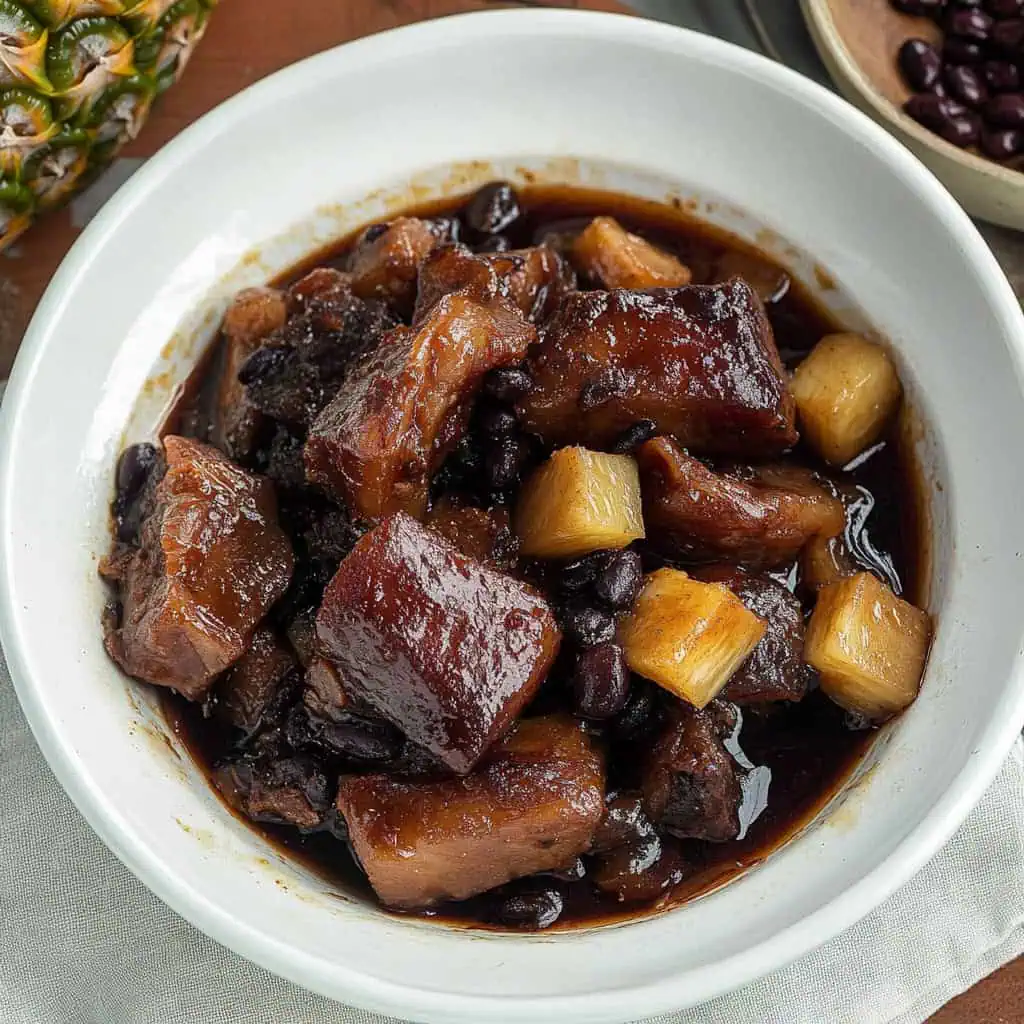









Comments
No Comments